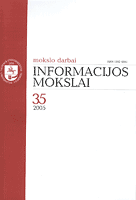Informacija ir esatis Aristotelio ir Tomo Akviniečio minčių kontekste
Information and Being in the Context of Ideas of Aristotle and Aquinas
Author(s): Algirdas BudrevičiusSubject(s): Economy
Published by: Vilniaus Universiteto Leidykla
Summary/Abstract: Progress in the twentieth century relied significantly on the advance and development of computers. Computer networks and internet has created a situation where parallel to the material reality emerged an informational component of reality. This new component had no place in the theories of reality of the past. Now, however, it also still has no adequate theoretical basis. Its basic concept, the idea of information has many interpretations now: it is related to the reduced uncertainty in the theory of Shannon, treated as negative entropy by Schroedinger, given parallel to the idea of knowledge by many authors of encyclopedias and dictionaries, and considered a data by computer professionals. Computer data is the lower, but fundamental level of information. This level is considered here mainly. The purpose of this paper is to discuss the place of the said fundamental level of information in the context of being. A framework of the classical Aristotelian theory of being, the theory of hilomorphism (of form and matter) is used as a starting point. Later ideas of Aquinas and other schoolmen (scholasts) are taken into account as well. The first main theoretical idea of this paper is to develop a coordination system for the compositions of form and matter that are considered as binary entities of being. The second idea is interpretation of the system from the viewpoint of information. The system establishes an order between binary entities of being. Each entity consists of the form and matter, as well as their privation. Four binary entities of being are determined according to the system: matter and privation of form, form and matter, form and privation of matter, privation of form and privation of matter. The binary entities are interpreted accordingly as follows: the material indicators (they may be interpreted as unprocessed, raw data, analogue information), the thing (the concrete object, or concrete substance, “informed matter” for Aristotle), the formal structure (it may be interpreted as computer data, information), the absence of the object (no-thing, it also may be related with the idea of entropy and not-information). This interpretation is in agreement with some well-known statements of Wiener (“Information is information, neither matter nor energy”), Schroedinger (“Information is a negative entropy”), and Shannon (information is the reduced uncertainty) concerning the idea of information. The ideas of this paper does not necessarily completely agree with the Aristotelian hilomorphism theory; the latter was taken here only as a starting point to establish the place of information in the system of being. However, when approaching the idea of being, we tried to remain as close as possible to the viewpoint of Aristotle and tried not to use later theories of being, in particular, those based on the idea of intentionality.
Journal: Informacijos mokslai
- Issue Year: 2006
- Issue No: 38
- Page Range: 122-134
- Page Count: 13
- Language: Lithuanian

